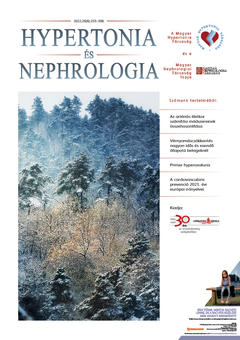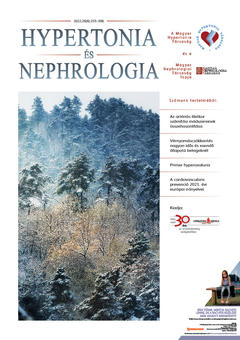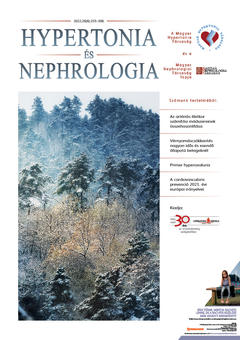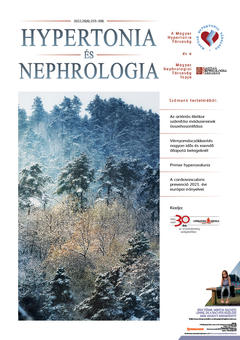The eLitMed.hu medical portal uses computer cookies for convenient operation. Detailed information can be found in the Cookie-policy.
Hypertension and nephrology - 2022;26(6)
Content
[Comparison of different cardiovascular risk score, pulse wave velocity and coronary artery calcium score- based methods for vascular age calculation]
[Background: The calculation of vascular age can help patients understand the importance of preventive strategies. However, multiple methods are available to calculate vascular age and no comparison data is available yet. ]
[Variation in GP decisions on antihypertensive treatment]
[We conducted an online questionnaire survey with 2543 family physicians to analyse the variation in antihypertensive therapy among very elderly primary care patients (over 80 years of age) with different characteristics in terms of prevalence, SBP and CVD. We also sought answers to our question of how much their treatment decisions are influenced by their elderly frailty. Another aim of our study was to compare Hungarian results with international results. We compared the proportion of cases in which family doctors decided in favour of treatment across countries. In 24 of the 29 countries (83%), family physicians associated the patient's frailty with the decision not to initiate treatment. The lowest treatment rate was in the Netherlands and the highest rate in Ukraine. Hungary was one of the countries where family physicians preferred to treat patients with frailty (treatment rates ranged from 50-59%). Patient’s frailty did not influence the initiation of therapy, cardiovascular disease and SBP above 160 mmHg were more important. The main message from the study was the need for continued education of family physicians and family medicine residents on the management of elderly, frail hypertensive patients.]
[Primary hyperoxaluria. Facts and perspectives]
[Primary hyperoxaluria is a rare metabolic disease. As a result of the glyoxylate metabolism disorder, large amounts of oxalate are formed, which due to poor solubility leads to oxalosis. Oxalosis first affects the kidneys and in milder forms lead to urolithiasis, nephrocalcinosis and in severe cases end-stage renal disease develops. The disease type can be accurately identified by genetic testing. Its clinical appearance is quite variable. In milder cases the aim is to reduce oxalate production and to inhibit its precipitation. In more severe cases, renal replacement therapy may be required. To date liver transplantation is the only curative intervention. Biological therapy based on the inhibition of the main enzyme involved in oxalate formation by RNA interference may offer new perspectives in the complex treatment of the disease.]
[European guidelines of cardiovascular prevention 2021]
[In August 2021, the European Society of Cardiology and 12 other scientific societies published their guidelines on “Prevention of cardiovascular disease in clinical practice”. The guidelines provides a comprehensive review of the risk factors of atherosclerotic cardiovascular disease, their assessment, potential risk factors modifiers, treatment of risk factors, and prevention of cardiovascular disease at the societal and individual level. The previous guidelines, issued in 2016, needed to be updated due to recent significant advances in the prediction of the risk of atherosclerotic origin cardiovascular disease and the beneficial effects of treatment, the emergence of new drugs and therapeutic targets. The risk assessment system has undergone a major overhaul and now predicts the risk of fatal and non-fatal cardiovascular events together over a 10-year horizon and over a lifetime. In the new guideline, age plays a more important role in risk classification than before. The risk assessment and staged management of apparently healthy people or patients with established atherosclerotic cardiovascular disease, diabetes mellitus and other specific diseases or conditions are detailed. The positive impact of influencing risk factors, the years of life gained can now be presented in a lifetime perspective, which will help to make a personalised, shared decision on the extent of interventions, taking into account the patient’s preferences. The new guidelines also present in detail the cardiovascular risk modifiers, co-morbidities, the principles of personalised treatment, and prevention at the individual and societal level.]
[An overview of the treatment of chronic kidney disease with peculiar regarding to the use of dapagliflozin]
[Chronic kidney disease (CKD) affects more than 1.5 million people in Hungary through the increase in the frequency of hypertension and diabetes. Keeping blood pressure within the target range reduces the risk of end-stage renal disease in patients with chronic renal disease with proteinuria, but also in patients with non-proteinuria CKD. Regardless of the treatment of the underlying disease, therapy is with an ACE inhibitor or ARB. Inhibition of SGLT2 has been shown to protect glomeruli through tubuloglomerular feed-back through afferent vasoconstriction in the diabetic and non-diabetic chronic renal patients with non-proteinuria and to reduce glucose and sodium concentrations in tubule cells. Dapagliflozin, when used in CKD, slows the progression of the disease in diabetic and non-diabetic patients (evidence A). They improve glomerular function, reduce protein excretion. A reduction in the number of newly developing diabetic patients and an increase in hematocrit have also been demonstrated during treatment.]
[Pickering syndrome: flash pulmonary oedema and renal artery stenosis in a nephrectomized patient with one functioning kidney]
[Flash pulmonary edema is a unique form of acute decompensated heart failure caused by sudden increase of left ventricular end-diastolic pressure. Most frequent risk factors are uncontrolled hypertension, myocardial ischemia, heart valve abnormalities. Its less frequent causes are bilateral renal artery stenosis (RAS) or renal artery stenosis in a single functioning kidney. We present the case of a nephrectomized patient with one functioning kidney who was started on dialysis due to acute-on-chronic renal failure and flash pulmonary edema. Following successfull radiological intervention of an instent restenosis in the previously balloon dilated and stented right renal artery the renal function improved and dialysis could be stopped.]
1.
Clinical Neuroscience
Is there any difference in mortality rates of atrial fibrillation detected before or after ischemic stroke?2.
Clinical Neuroscience
Factors influencing the level of stigma in Parkinson’s disease in western Turkey3.
Clinical Neuroscience
Neuropathic pain and mood disorders in earthquake survivors with peripheral nerve injuries4.
Journal of Nursing Theory and Practice
[Correlations of Sarcopenia, Frailty, Falls and Social Isolation – A Literature Review in the Light of Swedish Statistics]5.
Clinical Neuroscience
[Comparison of pain intensity measurements among patients with low-back pain]1.
Clinical Neuroscience Proceedings
[A Magyar Stroke Társaság XVIII. Kongresszusa és a Magyar Neuroszonológiai Társaság XV. Konferenciája. Absztraktfüzet]2.
3.
Journal of Nursing Theory and Practice
[A selection of the entries submitted to the literary contest "Honorable mission: the joys and challenges of our profession" ]4.
Journal of Nursing Theory and Practice
[End of Life and Palliative Care of Newborns in the Nursing Context]5.
Journal of Nursing Theory and Practice
[Aspects of Occupational Health Nursing for Incurable Patients ]







